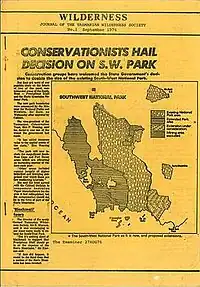The Wilderness Society (Australia)
The Wilderness Society is an Australian, community-based, not-for-profit non-governmental environmental advocacy organisation.
 | |
| Founded | 1976, Hobart, Tasmania, Australia |
|---|---|
| Focus | Environmentalism, Peace |
| Location |
|
Area served | Australia |
| Method | Nonviolence, Lobbying, Research, Innovation |
| Website | www.wilderness.org.au |
The society is organized as a public company limited by guarantee.[1] It has separately incorporated campaign centres, passed in the capital of each Australian state (plus Launceston and Newcastle).[1] Most campaign centres are separately incorporated and operate as membership organizations: The Wilderness Society Newcastle Incorporated, The Wilderness Society (South Australia) Inc, The Wilderness Society (Sydney) Inc, The Wilderness Society (Tasmania) Inc, The Wilderness Society Victoria Inc, and The Wilderness Society WA Inc.[1]
History

The Wilderness Society was formed initially as the Tasmanian Wilderness Society (TWS) and was transition from the South West Tasmania Action Committee.

The group was originally established in 1976 from the members of the Lake Pedder Action Committee and the South West Tasmania Action Committee Along with the United Tasmania Group, they had protested against the earlier flooding of Lake Pedder. The group already had established interstate branches as the South West Tasmania Action Committee (in NSW branch the word "Action" was not included), so it was already a nationwide organisation. Significantly, all but four of the twenty-three people attending the inaugural meeting of the Tasmanian Wilderness Society in 1976 were members of the United Tasmania Group.[2]
The campaign to save the Franklin River took seven years, 1976-83. The Tasmanian Wilderness Society played a key role. On 1 July 1981, works were stopped on the Franklin Dam when the High Court ruled that, in upholding the World Heritage Convention, Labor Prime Minister Bob Hawke’s government could overrule Tasmanian premier Robin Gray. Following the success of the campaign against the Franklin Dam, and the national approach being more important due to other issues interstate, it became known as The Wilderness Society.
In the year 2005, Tasmanian forestry business Gunns brought a litigation case against the group in the Melbourne Supreme Court, in a case dubbed the "Gunns 20", claiming that the activities of environmental activists had damaged Gunns' profits. Gunns claimed $3.5 million from the Wilderness Society, but in March 2009, Gunns was ordered to pay the Wilderness Society $350,000 in damages and to cease the action.[3]
Campaigns
The Wilderness Society spent considerable energy in its first decades of existence arguing that wilderness was a specific quality in parts of Australia's environment that was vital to preserve for future generations. The political response in most states of Australia is that there are now wilderness inventories and acknowledgement of areas of wilderness.
The Wilderness Society's campaigns have included:
- the Franklin river (Franklin Dam controversy)[4]
- stopping logging in old growth forests[5]
- preventing destruction of endangered species habitats;
- protecting Queensland's Wild Rivers[6] and Cape York Peninsula;
- nationwide campaign to mitigate the effects of climate change keep fossil fuels in the ground;[7]
- the Kimberley Campaign; as part of its long-running campaign against a proposal to industrialise the James Price Point headland near Broome, the organisation presented a concert on 5 October 2012. The concert featured performances from The John Butler Trio, Clare Bowditch and Missy Higgins, and a speech by the former leader of the Australian Greens and former TWS director, Dr Bob Brown.
- since 2018 they have been focused on New Nature Laws - campaigning for strong, national nature laws and an independent watchdog agency to enforce these[8]
Funding
Traditionally fundraising was performed through The Wilderness Society Shops. The shops were particularly popular for their calendars and posters by photographers such as Peter Dombrovskis and Olegas Truchanas, and were also central locations for the public to make donations and for members to meet.
Since the rise of the internet, fundraising has increasingly become centralised around internet based activities, such as the TWS website, online store[11] and extensive email lists, although it also still contacts supporters through regular postal communications as well.
The Wilderness Society now raises funds through a number of sources, mainly donations, including advocacy gifts and gifts in wills (bequests), subscriptions from members, grants, sales of merchandise, and interest and other investment income.[12] The Society reported a total income of $11,848,203 in 2022 and $12,285,437 in 2021.[13] These funds are primarily raised through donations, bequests, members subscriptions and grants. Total expenses for 2022 were $10,329,462.
In 2021 the Wilderness Society reported receiving $869,000 in COVID-19 relief subsidies.
Political involvement
The inaugural director of The Wilderness Society was Kevin Kiernan, followed by Norm Sanders, who was later elected to the seat of Denison in the Tasmanian Parliament in 1980 for the Australian Democrats. He was Australia's first parliamentarian to be elected on an environmental platform. Bob Brown became the director of The Wilderness Society in 1978, and with him the group increased their influence on Tasmanian politics. Brown was elected to the Tasmanian parliament in 1983 to fill the vacancy left when Sanders resigned his seat, and with the group of fellow conservationists elected subsequently, he went on to become part of the political party known as the Tasmanian Greens. Brown was later elected to represent Tasmania and the Greens in the Senate in the Federal parliament.
While The Wilderness Society has worked with the Australian Greens on certain campaigns, it is not affiliated with them or any other political party, as a politically unaligned environmental non-government organisation.
Wilderness Journal
The society publishes the Wilderness Journal,[14] which covers a wide variety of stories about nature and people. Topics include the communities and forests of East Gippsland, a photo diary by Ben Baker of a road trip through bushfire damaged regions, a story about Marina DeBris and the ugly beauty of our trash, attempts to restore the giant kelp forests of Tasmania, and a journey into Mirning country, the coast and waters of the Great Australian Bight.
References
- About us, The Wilderness Society.
- Pam Walker, The United Tasmania Group, University of Tasmania Honours thesis, 1986
- "Wilderness Society wins David and Goliath battle against Gunns". Australian Broadcasting Corporation.
- Reimer, Asha Miriam Stobbe (30 September 2021). "Tasmanian Wilderness Society blocks dam construction (Franklin River Campaign) 1981-83". The Commons Social Change Library. Retrieved 3 March 2023.
- "Protecting nature". Wilderness Society. Retrieved 30 March 2023.
- "Support the life that supports you". Wilderness Society. Retrieved 30 March 2023.
- "Our work".
- "Nature laws that work". Wilderness Society. Retrieved 30 March 2023.
- "Come clean on nukes: Wilderness Society". ABC News. 23 October 2007. Retrieved 17 August 2023.
- "Aust to be world's N-dump: Wilderness Society". Brisbane Times. 20 July 2007.
- "Wild Shop". Official website. The Wilderness Society. Retrieved 15 September 2014.
- website "Get Involved". The Wilderness Society. Retrieved 26 April 2013.
{{cite web}}: Check|url=value (help) - "Australian Charities and Not-for-profits Commission". ACNC.
- "Wilderness Journal". journal.wilderness.org.au. Retrieved 30 March 2023.
Further reading
- Gee, H and Fenton, J. (Eds) (1978) The South West Book – A Tasmanian Wilderness Melbourne, Australian Conservation Foundation. ISBN 0-85802-054-8
- Lines, William J. (2006) Patriots : defending Australia's natural heritage St. Lucia, Qld. : University of Queensland Press, 2006. ISBN 0-7022-3554-7
- Neilson, D. (1975) South West Tasmania – A land of the Wild. Adelaide. Rigby. ISBN 0-85179-874-8
